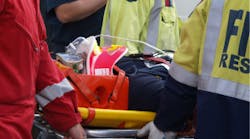On August 16, 2007, Master Electrician William Giffen, owner of CAMAND Electrical Services, Ottawa, Canada, and experienced 17-year veteran of electrical maintenance services, was testing secondary fuses at a high-tech data center (after it was hit by lightning for the second time that day) when he was caught in an arc-flash incident at a 13.8kV switch. “I misread how the switch was designed and didn't realize that the switch was back-fed,” explains Giffen, meaning that he assumed the switch was dead when, in fact, it was live.
Earlier that day, wearing the appropriate personal protective equipment (PPE) and following the proper safety procedures, Giffen and his staff successfully performed isolation on the affected fuses following the first lightning strike. However, after the second lightning incident, Giffen reviewed the situation with the electric utility personnel brought on-site to check the transformer that had gone down. “At that time, we had a miscommunication and skipped a few procedures,” Giffen explains.
Therefore, when Giffen stepped in to retrieve the fuse — approximately the size of a case of beer, he says — his ankle came in contact with one of the back-fed phases. “That's when the arc occurred, and I was blown out,” he says.
With the switch still exploding, Giffen's crew dragged him away from the scene and put out the fire on his leg, which was covered in third-degree burns from ankle to knee (see SIDEBAR: First Aid Following an Electrical Accident below). In addition, there were second-degree burns on his arm, back, and groin area. “One of the first things I told my crew was, ‘Tell my wife and kids I love them,’” Giffen says. “I was lying on my back, and I thought my leg was gone. I was so locked up that I was sure my heart was going to stop.”
What doesn't kill you
Giffen's fear for his life was not exaggerated. Some electrical contacts are instantly fatal, while up to 40% are ultimately fatal, according Brian James Daley, M.D, associate program director, professor, Department of Surgery, Division of Trauma and Critical Care at the University of Tennessee School of Medicine, Knoxville, Tenn., in his report, “Electrical Injuries.”
Historically, of all the industries tracked by the Bureau of Labor Statistics (BLS), the construction industry comprises the greatest number of electrical fatalities, say Brent C. Brenner and James C. Cawley, on behalf of the Electrical Safety Foundation International (ESFI), in their report, “Occupational Electrical Injury and Fatality Trends and Statistics: 1992-2007.” From 2003-2007, of the 1,213 occupational electrical fatalities the BLS recorded, according to the report, 52% occurred in construction, with electrical construction workers accounting for half of that.
In fact, the fatality rate involving workers coming in contact with wiring, transformers, or other electrical components — work performed by electricians and electrical contractors — accounted for 28% of electrical fatalities from 2003-2007 and is second only to the rate related to construction workers coming in contact with overhead power lines, according to ESFI. Work involved in mechanical and electrical maintenance, including accidental electrocution due to faulty or missing grounding conductors for machines, tools, appliances, or light fixtures, accounts for 18% of electrical-related fatalities in construction, making it the third leading category.
However, as Giffen's accident proved, not all electrical-related accidents result in electrocution. The total for nonfatal occupational electrical-related injuries for 2003-2007 totaled 13,150. The leading category of nonfatal electrical-related accidents in the construction industry, comprising 37%, is contact with wiring, transformers, or other electrical components, followed closely by electrical contact through machines, tools, appliances, or light fixtures at 35%, according to the ESFI report. From 2003-2007, there were 4,100 nonfatal electrical injuries in the construction industry, divided between 2,390 electrical burn injuries and 1,710 electrical shock injuries. For more details on the ESFI study on electrical injuries and fatalities, turn to “Workplace Accident Update” on page 26 of this issue.
Path of destruction
However, not all incidents of electrical contact result in severe electrical injury or time off from work. A recent survey of electrical workers by the Electrical Trauma Program at the University of Chicago, reveals that 96.7% of respondents had experienced an electrical shock over the course of their professional experience, yet only 11% had sought medical attention.
“There's a large number of people who receive very minor shocks in their household or in the context of the work environment, and there's no symptomatology,” says Michael Morse, Ph.D., a San Diego-based electrical injury expert. “They dust themselves off, and they're fine. They may suffer a period of exhaustion after the shock, but then they recover — and there's no reason to go see a doctor.” According to Morse, probably the majority of shocks fall into this category.
The type and severity of electrical injury depends on the amount, duration, and the path of the electrical contact (click here to see Table). “It also depends on if they have additional diseases that may place them at risk,” says Mike McCann, Ph.D., director of safety and research, Center for Construction Research and Training (formerly known as the Center to Protect Workers' Rights or CPWR), Silver Spring, Md. Pre-existing heart or respiratory problems may be exacerbated by electrical contact.
Electrical injury symptoms range from the absence of any external physical signs to severe multiple traumas (see SIDEBAR: Presentation of Electrical Injury Symptoms below). The most common symptoms of electrical injury are burns (see SIDEBAR: The Most Common Nonfatal Electrical Injury below), followed by cardiac and/or respiratory arrest, and blunt trauma, such as fractures of the long bones/spine and dislocation of major joints, as a result of a fall or being thrown from the power source. Peripheral injuries include ruptured eardrums.
In most cases, the neuro- and muscle tissues suffer the most as a result of electrical injury. Therefore, some of the most serious injuries may not immediately be visible. “The electricity has to get across from one place to another,” McCann explains. “You'll see a small little burn on the hand and then a blowout through the foot, so that means the current has traversed across all those tissues in between, but you don't see a burn.”
This type of injury can lead to fluid collection or compartment syndrome, and result in amputation. “That's the main thing to worry about,” McCann says. “The skin on the outside will look normal, yet it will cause the victim to lose the muscle, which can lead to amputation.”
In fact, the limb amputation rate for victims of direct electrical contact can be as high as 75%.
Shock to the system
The electrical injury patients treated at the Division of Trauma and Critical Care at the University of Tennessee, Knoxville, Tenn., are mostly severe, high-voltage cases, meaning people who are unconscious and requiring intensive care unit-level treatment. “In most incidents, the hand will contact the electricity, and either the lower extremity will be the point of path, so it will go down through the torso and out the lower extremities, which saves the central nervous system, or it traverses across the thorax, and it involves the heart,” Daley explains.
Because electrical injury often involves current passing through one or both hands, an evaluation to determine muscle strength, joint motion, endurance, grip strength, and sensitivity to external stimuli (such as extreme temperature and sharp objects) should be performed.
Many electrical trauma patients also experience pain or decreased sensation in their legs. After numerous skin grafts, as Giffen's nerves healed, he experienced the sensation of “bee stings” in his leg. “I was back to work three months after the accident, but being on a ladder was difficult,” he notes. “You feel like you're getting stung, so being on a ladder is awkward.”
Only recently has the tingling in Giffen's leg stopped being so violent.
In the rare case of diffuse electrical injury (DEI), there is no correlation between path of current and symptoms, such as muscle aches and tremors, incontinence, arthritis, and general fatigue, which may seem unrelated to the electrical contact and manifest minus diagnostic evidence. In addition, the symptoms are disproportionate to the voltage, current, or wound size of the electrical contact, which is usually a low- to moderate-voltage shock. “DEI is a descriptive term for a rare constellation of symptoms developed over a long period of time after a low- to moderate-voltage shock,” Morse explains. “It has a life-altering quality to it.”
After shocks
Most individuals will have a normal post-traumatic response, according to Daley. “It's just a question of whether it starts to impede or impair their activities for daily living or a return to work,” he explains.
In such cases, electrical injury survivors may experience what is called “postelectric shock syndrome,” which consists of a host of persistent and progressive cognitive and psychological symptoms, resembling those in mild to moderate traumatic brain injury.
This can occur even when there was no contact between the head and the electrical power source. An MRI test can be used to determine whether electrical contact has affected the functioning of the brain and a neuropsychological evaluation tests for attention, memory, problem solving, coordination, and psychological functioning.
In cases of post-traumatic stress disorder (PTSD) following an electrical injury, treatment is imperative. “When the patient does not get help, PTSD tends to get worse, and family relationships become very strained,” says Margaret Primeau, Ph.D., professor, Psychiatry and Behavioral Neurosciences, Loyola University Health System, Maywood, Ill. “Individuals who have been injured may feel worthless if they are not the family breadwinners anymore. For instance, a father might become withdrawn and stop participating in family events.”
Chronic pain is also a very common symptom and a complex problem for survivors of electrical contact. Immediately after the incident, intravenous narcotics may be administered in frequent, small doses. However, this must be carefully monitored, because in some cases, electrical injury may also increase risk for substance abuse, mainly through self-medication with alcohol or the overuse of prescription medications, although some studies say there is no increased risk for addiction. “Working with a team helps minimize the risk since a multi-modal approach works best (besides pills, you need exercise, coping skills, better sleep, less worry, etc.),” Primeau says.
After his release from the hospital, Giffen battled an addiction to the morphine his caregivers had given him for the pain. He wasn't offered additional support or therapy. “My plastic surgeon patted me on the back and said, ‘Have a nice life, and keep your leg out of electrical switches,’” he says.
Pain management is tailored to the individual, says Daley. As a trauma surgeon, he attends to the acute pain. “For things like chronic pain or the complex regional pain syndromes (CRPS), we let our physical medicine folks deal with that. That's long-term rehabilitation for physical therapy and medical management.”
In the absence of a direct correlation with the initial electrical injury, symptoms of postelectric shock syndrome may cause skepticism and controversy in medical and legal areas. “If a worker is involved in a legal dispute, such as product liability, there is a possible assumption by others that he or she doesn't want to get well until the case is settled,” Primeau says, who goes on to explain that research has shown that having a lawsuit ongoing — or having it settled in the past — did not differentiate the workers with neuropsychological problems versus those without problems.
Still, sufferers of neuropsychological and behavioral effects of electrical contact are often isolated in a way that those already in the medical system aren't. “Of course, if you've suffered substantial burns, PTSD and depression, following the electrical contact, are quite common, and obviously these patients are treated by psychologists and psychiatrists,” Morse says. “There's a whole medical community out there that accepts that symptomatology as a consistent side effect to the original burn injury.”
However, those that don't suffer an immediate burn injury or substantial immediate injury don't have the same medical community, according to Morse. “What usually happens with them is that over a period of time they develop the symptoms,” he says. “But because they didn't suffer an immediate burn injury or an acute immediate injury, they are not linked into the medical community as the burn victim would be.”
Clinical data suggest that if a multi-disciplinary rehabilitation plan is undertaken early after electrical contact and is strictly followed by the patient, chances for successful rehabilitation increase significantly. Therefore, neuropsychological and psychiatric testing/treatment is a vital part of recovery from electrical injury.
“In general, it is important to have the option of both medication and talk therapy for mood problems,” Primeau says. “Antidepressants are used for patients with depression and/or pain problems. Behavioral therapy (talk therapy) is synergistic with medications — a medication helps you regain some well-being so that you can take advantage of the therapy for improving your stress management and problem-solving. The best way to treat PTSD is cognitive behavioral therapy (CBT). Family involvement is good in order to educate and give support to the spouse and children when there have been a lot of changes due to the injury.”
In addition, membership to a support group like Lightning Strike and Electric Shock Survivors International, Jacksonville, N.C., can be made available.
There is hope for recovery, according to Primeau. “Good outcomes for PTSD in general take about six to 10 weeks of weekly psychotherapy,” she says. “In general, improvement in depression with medication takes about three months; some people need more time in order to switch to a different medication that works better for them. Treatment of pain problems is hard to generalize.”
The best medicine
Electrical injuries cost employers approximately $15.75 million per case in direct and indirect costs, according to a recent study by Dr. Ronald Wyzga of the Electric Power Research Institute, Palo Alto, Calif. Fines and court costs comprise just a portion of these costs, which can also include work stoppages, lost contracts, and the cost to replace employees experiencing lengthy rehabilitation periods. It's much more economical to focus on prevention.
Contractors should comply with OSHA regulations on electrical safety, train employees on electrical safety, and only allow work on live electrical circuits/parts in accordance with a permit system with specific procedures per NFPA 70E: “Standard for Electrical Safety in the Workplace.” Electrical workers should wear appropriate PPE and use proper tools, and work on de-energized equipment whenever possible and when allowed by NFPA 70E. “Sometimes people have to work live,” McCann says. “But I've heard of cases where electrical workers were killed on a job putting a new machine into the line. They wanted to cut the power so it would be safe, but the company wouldn't allow them to. It turns out that the owner didn't want to lose his air-conditioning. Unfortunately, that type of thing happens. You really should de-energize.”
In an effort to reach its goal of zero electrical fatalities per year, ESFI recently launched the “Never Assume Electrical Safety Series,” which is the foundation's most advanced resource addressing workplace safety. Developed by a panel of safety experts, the series is a collection of comprehensive video modules and related materials geared toward electrically qualified individuals working in industrial and construction environments. It is just the beginning to new steps the foundation will take to help bring its goal of zero electrical fatalities to fruition.
To prevent accidents similar to the one he lived through, Giffen started the Web site arcflashsurvivor.com, where he shares his experiences with trauma and recovery. He also travels to firms to give safety presentations. He asks that companies donate a portion of the honorarium to Canadian Trauma or burn centers. “My mission is to bring the very real face of an accident to contractors and their employees,” Giffen says. “My sincere hope is that, after my presentation, each and every person will appreciate what taking a moment to do the right safe thing will spare them forever.”
SIDEBAR: First Aid Following an Electrical Accident
Immediately following an incident, turn off the power source. The victim may still be part of a live circuit, and any attempt at rescue will endanger others. “A lot of people have been electrocuted by touching someone who is in contact with power,” says Michael McCann, Ph.D., director of safety and research, Center for Construction Research and Training (formerly known as the Center to Protect Workers' Rights or CPWR), Silver Spring, Md. “If you can't immediately cut off the power, you want to try to get the person away from the contact with insulated gloves or other insulated object.”
Once the victim is free of the circuit, provide basic life support at the scene. Call out to the victim to check for consciousness. If the victim is conscious, advise him/her not to move. Examine the victim's body for major bleeding. If there is bleeding, place a cloth over the wound and apply pressure. Keep the victim warm.
If the victim is not awake, check signs for breathing, while moving the victim as little as possible. In victims with cardiac or respiratory arrest, a CPR-trained person should secure the victim's airway and start artificial breathing and chest compressions. To be effective, CPR must be performed within 4 min. of the shock. To prevent further burns, remove smoldering clothing.
SIDEBAR: Presentation of Electrical Injury Symptoms
“Most importantly, activate the emergency medical services (EMS) system, so that professionals can get there and get the patient ready for transport,” says Brian James Daley, M.D., associate program director, professor, Department of Surgery, Division of Trauma and Critical Care at the University of Tennessee School of Medicine, Knoxville, Tenn. Victims of electrical contact involving voltages measuring 600V or more should be transported to the emergency department for further evaluation. Victims with injuries resulting from low-voltage contact should also be transported to the emergency room if they have symptoms of serious injury, such as a racing heart.
The type and severity of physical trauma caused by electrical contact depends on the amount, duration, and path of the shocking current through the body.
Symptoms commonly exhibited immediately after the electrical incident:
- Flexor spasm of the muscles, which keeps the victim locked onto the electrical contact; entry and exit point burns, as well as burns to tissues (nerve fibers).
- Myoclonic jerk, which causes the victim's body to be thrown away from the source of electricity. This can cause secondary injuries as a result from a ladder or other heights; brief seizures, followed by a short period of unconsciousness.
- Cardiac arrhythmias and brief cardiac arrest, which generally responds to resuscitation and is often followed by abnormal cardiac rhythm, fluctuating blood pressure, stomach and chest pains, and apnea.
- Blisters or discoloration on the victim's fingers and chest, especially near the entry and exit wounds.
Symptoms commonly exhibited after an electrical incident, generally exhibited during hospitalization:
- Fatigue, confusion, and lethargy.
- Changes to vital signs, such as blood pressure, in the first 24 hr.
- Vertigo and tinnitus.
- Pain at entrance and exit points and complex regional pain syndrome (CRPS) in tissues in path of current.
- Asymmetrical sensory loss on body due to effect of electricity on the spinal cord.
- Possible tremors, positive snout reflex (meaning pouting or pursing of the lips that is elicited by light tapping of the closed lips near the midline), absence of expression, irritability, and poor judgment.
Symptoms commonly exhibited within the first few weeks to months after the electrical incident:
- Pain in extremities, CRPS.
- Anxiety, agitation, phobia, irritability, loss of recent memory, depression, insomnia, and fatigue.
- Cardiac arrhythmias, high blood pressure, chest pain.
Symptoms commonly exhibited more than six months after the electrical incident:
- Vertigo and tinnitus.
- Severe depression, anxiety, phobia, memory loss.
- Seizures.
- Impotence, abdominal cramps, and chronic tremors.
SIDEBAR: The Most Common Nonfatal Electrical Injury
Burns are the most common nonfatal electrical injury. Entry (or source/contact) burn wounds are common on the victim's hands or skull, and exit (or ground) point burns most often show up on hands and heels. Sometimes, multiple contact and ground points may be visible. The size of the entry/exit burns is not an accurate indication of the extent or depth of underlying tissue damage. A “kissing burn” at the upper extremity flexor creases from an electrical arc generally indicates extensive underlying tissue damage.
Source: “Guidance for Emergency Medical Management of Electrical Injuries,” by Piper Lillard, DO, MPH. This report was developed in partnership with the Massachusetts Coalition for Occupational Safety and Health with technical assistance provided by the Occupational Health Surveillance Program, Massachusetts Department of Public Health



